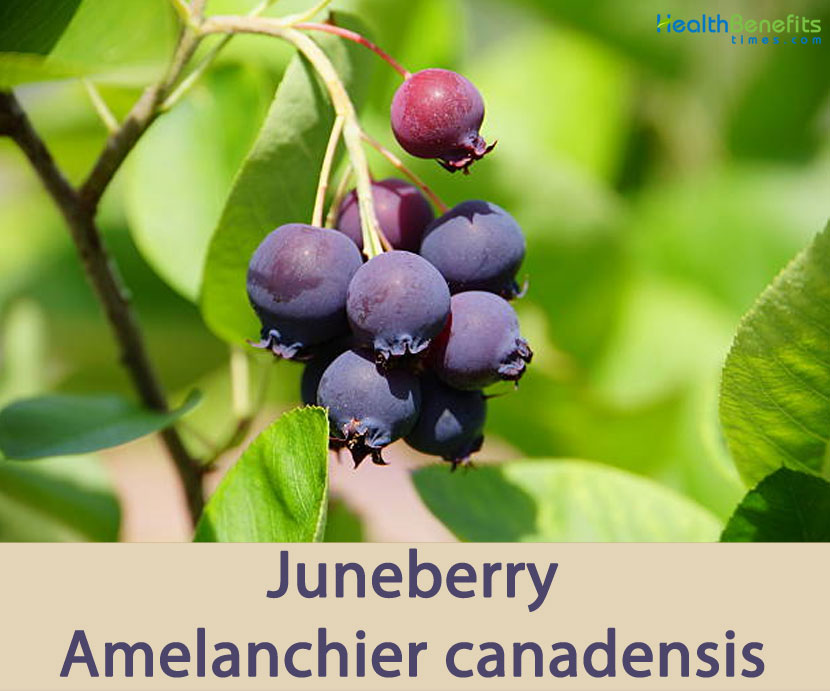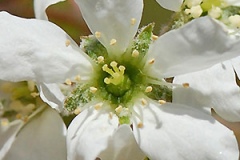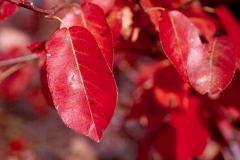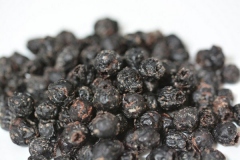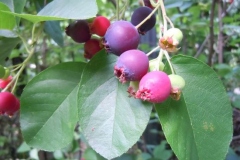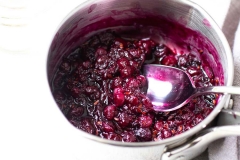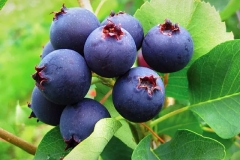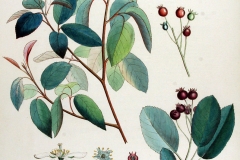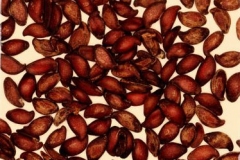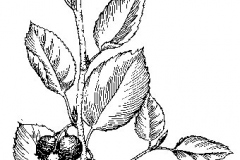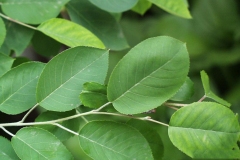| Juneberry Quick Facts | |
|---|---|
| Name: | Juneberry |
| Scientific Name: | Amelanchier canadensis |
| Origin | Eastern North America in Canada from Newfoundland west to southern Ontario |
| Colors | Initially green turning to red and finally mature to a dark purplish-black |
| Shapes | Small, soft, pome (berry-like) clustered like the flowers on short stalks |
| Health benefits | Stronger Immune System, Younger-Looking Skin, Healthier Gums, Stronger Teeth and Bones, Lowered Heart Disease Risk, Regulated Bowel Movement, Reduced Risk of Cancer, Increased Muscle Strength |
| Name | Juneberry |
|---|---|
| Scientific Name | Amelanchier canadensis |
| Native | Eastern North America in Canada from Newfoundland west to southern Ontario, and in the United States from Maine south to Alabama. It is largely restricted to wet sites, particularly on the Atlantic coastal plain |
| Common Names | Serviceberry, shadbush, shadblow, sarvice, Juneberry, wild currant, bilberry, Canadian serviceberry, chuckle-berry, currant-tree, shad-blow serviceberry, shadbush, shadbush serviceberry, sugarplum, thicket serviceberry, Canada shadbush, thicket serviceberry, shadblow serviceberry, Snowy-mespilus, Eastern serviceberry, Shadblow, Swamp shadbush, eastern shadbush, downy serviceberry |
| Name in Other Languages | Afrikaans: Juneberry Albanian: Juneberry Amharic: Junīyeri (ጁኒየር) Arabic: Sharab altawt (شراب التوت) Armenian: Hunisin (հունիսին) Azerbaijani: Juneberry, Kanada irqası Belarusian: Írga kanadskaya (Ірга канадская) Bengali: Juneberry-ˈjo͞onˌberē Bulgarian: Juneberry-ˈjo͞onˌberē Burmese: Jwanl (ဇွန်လ), nain (နင်) Chinese: -Liù yuè (六月) Croatian: Juneberry Czech: Juneberry Danish: Juneberry Dutch: Juneberry, Canadees krentenboompje English: Juneberry, Canadian serviceberry, Shadbush, Snowy-mespilus, Thicket serviceberry, Canada serviceberry, Eastern serviceberry, Shadblow, Swamp shadbush, eastern shadbush, downy serviceberry, shadbush serviceberry Esperanto: Januaro Estonian: Juunior, Kanada toompihlakas Filipino: Juneberry Finnish: Juneberry, Ruotsintuomipihlaja French: Juneberry, Amélanchier du Canada, Amélanchier canadien Georgian: Zhurnali (ჟურნალი) German: Juniberry, Kanadische Felsenbirne Greek: Juneberry-ˈjo͞onˌberē Gujarati: Jūnabērī (જૂનબેરી) Hausa: Juneberry Hebrew: ג’ונברי Hindi: Juneberry-ˈjo͞onˌberē Hungarian: Juneberry, Kanadai fanyarka Icelandic: Jarðarber Indonesian: Juneberry Irish: Lus na gréine Italian: Juneberry, nespolino del Canadà Japanese: Juneberī (ジュネベリー) Javanese: Juneberry Kannada: Jūnberri (ಜೂನ್ಬೆರ್ರಿ) Kazakh: Dzhuner (джунер) Korean: Jun beli (준 베리) Kurdish: Juneberry Lao: Juneberry-ˈjo͞onˌberē Latin: Catenulis Latvian: Jūnijs Lithuanian: Birželis Macedonian: Gubre (ѓубре) Malagasy: Juneberry Malay: Juneberry Malayalam: Jūṇbeṟi (ജൂൺബെറി) Maltese: Ġunju Marathi: Joonaberee (जूनबेरी) Mongolian: Juneberry-ˈjo͞onˌberē Nepali: Joonaberee (जूनबेरी) Norwegian: Juneberry Oriya: ଜୁନ୍ବେରୀ Pashto: جونیری Persian: جونبری Polish: Czerwiec Portuguese: Juneberry Punjabi: Jūnabērī (ਜੂਨਬੇਰੀ) Romanian: Juneberry Russian: -ˈJo͞onˌberē, Irga kanadskaya (Ирга канадская) Serbian: Juneberri (јунеберри) Siddhi: جونبيري Sinhala: Jūnberi (ජූන්බෙරි) Slovenian: Junerov Spanish: Juneberry Sudanese: Juneberry Swedish: Juneberry, Kanadensisk häggmispel Tajik: Codugarī (ҷодугарӣ) Tamil: Jūṉperri (ஜூன்பெர்ரி) Telugu: Juneberry-ˈjo͞onˌberē Thai: Juneberry-ˈjo͞onˌberē Turkish: Juneberry Ukrainian: Yahidnyk (ягідник), irha kanadsʹka (ірга канадська) Urdu: جونبیری Uzbek: Maymunjon Vietnamese: Tháng sáu Welsh: Juneberry Zulu: Juneberry |
| Plant Growth Habit | Small, woody, upright, twiggy, multi-stemmed large deciduous shrub or small tree |
| Growing Climates | Swamps, low ground, woods, thickets, woods, hedgerows, clumps |
| Soil | Prefers a rich loamy soil in a sunny position or semi-shade, but thrives in any soil that is not water-logged, too dry or poor, though it is more wet-tolerant than other members of this genus. Grows well in heavy clay soils. Prefers an acid soil |
| Plant Size | 20 to 30 feet in height with a spread of 15 to 20 feet |
| Trunk | Several smooth, gray trunks that grow up to approximately 26 ft tall (8 m) and 15–20 ft. (5–6 m) wide. They are ash-gray with dark stripes when young, and rough, with long furrows when older |
| Twigs | Slender, flexible, red-brown in color, may be covered with fine hairs when young; buds may be up to 1/2 inch long, pointed, covered with scales, may have hairy margins, light yellow-green to reddish yellow. |
| Bark | Bark is smooth when young, ashy-gray with darker (but faint) stripes; later becoming rough with long splits and furrows on mature stem. |
| Leaf | Alternate, simple, oblong, finely-toothed, rounded at base, and rounded at the apex with a small, sharp projection. They are 3–6 cm long and 2–3 cm wide |
| Flowering season | April |
| Flower | Flowers are produced in early spring in loose racemes 4–6 cm long at the ends of the branches; each raceme has four to ten flowers. The flower has five white petals 7.6–11 mm long and 2–4 mm broad, and 20 stamens. |
| Fruit Shape & Size | Small, soft, pome (berry-like) clustered like the flowers on short stalks |
| Fruit Color | Initially green turning to red and finally mature to a dark purplish-black |
| Seed | Red-colored, large, soft and shaped like teardrops |
| Lifespan | Up to 50 years in the wild. |
| Season | June and July |
| Health Benefits |
|
Plant Description
Juneberry is a small, woody, upright, twiggy, multi-stemmed large deciduous shrub or small tree that normally grows about 20 to 30 feet tall with a spread of 15 to 20 feet. The plant is found growing in swamps, low ground, woods, thickets, hedgerows and clumps. The plant prefers a rich loamy soil in a sunny position or semi-shade, but thrives in any soil that is not water-logged, too dry or poor, though it is more wet-tolerant than other members of this genus. It grows well in heavy clay soils and prefers an acid soil. The plant has several smooth, gray trunks that grow up to approximately 26 ft. tall (8 m) and 15–20 ft. (5–6 m) wide. They are ash-gray with dark stripes when young, and rough, with long furrows when older. Twigs are slender, flexible, red-brown in color, may be covered with fine hairs when young. Buds may be up to 1/2 inch long, pointed, covered with scales, and may have hairy margins, light yellow-green to reddish yellow. Bark is smooth when young, ashy-gray with darker (but faint) stripes; later becoming rough with long splits and furrows on mature stem.
Leaves
The leaves are alternate, simple, oblong, finely-toothed, rounded at base, and rounded at the apex with a small, sharp projection. They are 3–6 cm long and 2–3 cm wide, with 10–15 pairs of main veins. The tip forms an abrupt point, the base is somewhat rounded and vein pattern is pinnate. The young leaves are covered with a soft, fine hair and will become dark green and smooth with age. The underside of the leaf is covered with soft white hairs. The leaves are folded lengthwise down the middle in the buds rather than arranged in overlapping scales. The leaves will only be half grown during mid-bloom.
| Leaf arrangement | Alternate |
| Leaf type | Simple |
| Leaf margin | Serrate |
| Leaf shape | Elliptic (oval), oblong |
| Leaf venation | Pinnate, brachidodrome |
| Leaf type and persistence | Deciduous |
| Leaf blade length | Less than 2 inches, 2 to 4 inches |
| Leaf color | Green |
| Fall color | Yellow, orange, red |
| Fall characteristic | Showy |
Flower
The inflorescence is a short dense raceme, 2 to 3 inches long, at the end of the twigs before the leaves unfurl or with the leaves in the northern part of the plants range. The inflorescence can be quite hairy as the flowers and the new leaves open up. Most hair then drops away and the leaves become smooth on the upper surface.
The flowers of Juneberry are showy. The five white petals of the corolla are narrowly oblong, and the five lobes of the calyx are reflexed at flowering forming 5 conspicuous teeth which are hairy on inside and outside surfaces. Flowers usually have 19 to 21 stamens with yellow-green filaments and yellow anthers and the pistil from the ovary usually has 5 yellow-green styles (6 possible). Flowering normally takes place in between April.
| Flower color | White/cream/gray |
| Flower characteristics | Very showy |
Fruits
Fertile flowers are followed by small, soft, pome (berry-like) clustered like the flowers on short stalks. They are initially green turning to red and finally mature to a dark purplish-black in late summer, depending on the species and cultivar. Each pome consists of about 4 to 10 seeds. While Juneberry seeds are larger and more noticeable than those in blueberry, they are soft and not objectionable. Seeds are red-colored, large, soft and shaped like teardrops. Fruits are edible. Seed needs up to 60 days cold stratification to break dormancy. Sow fresh berries or seeds in the fall and let them overwinter.
Although commonly eaten “out of hand,” juneberries are also ideal for jams, syrups, juices, pies, rolls, and sweetbreads. Berries can be dried and marketed as a product similar to raisins. Juneberry starts to produce fruit 2 to 4 years after planting and reaches the peak (greatest quantity of the produced fruit) between the ages of 12 to 15 years. Under optimal conditions, Juneberry produces fruit until the age of 30 to 50 years.
| Fruit shape | Round |
| Fruit length | Less than .5 inch |
| Fruit covering | Fleshy |
| Fruit color | Red, purple |
| Fruit characteristics | Attracts birds; showy; fruit/leaves not a litter problem |
Health benefits of Juneberries
With so many ways to enjoy them, it can be very easy for you to make juneberries a part of your healthy eating habit. It’s for certain that you will enjoy plenty of health benefits for doing so because they are loaded with a variety of nutrients. Some of the benefits that juneberries offer include:
1. Stronger Immune System
Vitamin C is one of the most abundant nutrients you can obtain from juneberries. Needless to say, enjoying these fruits on a regular basis can help in lowering your chance of having an infection, like the common cold and flu. Especially if you are leading a stressful life, strengthening your immune system with juneberries can be advantageous.
2. Younger-Looking Skin
Other than making your immune system strong, vitamin C found abundantly in juneberries also helps make your skin remain looking young. That’s because vitamin is a role player in the synthesis of collagen. So if you want to keep unsightly wrinkles at bay, eat juneberries and other vitamin C-rich foods regularly.
3. Healthier Gums
Being loaded with vitamin C, consuming juneberries on a regular basis can also help keep your smile looking fabulous. It’s for the fact that vitamin C is important for healthy gums. If your gums are in a great shape, then it’s easy to keep your pearly whites strong.
4. Stronger Teeth and Bones
Juneberries consists of good amount of calcium, and this is the reason why adding these blueberry-like fruits in your diet is great for keeping your lovely smile intact. Calcium also helps in strengthening the bones, and that’s why regularly eating juneberries and other calcium-rich foods can help lower your osteoporosis risk.
5. Lowered Heart Disease Risk
Being rich in fiber, juneberries help remove cholesterol in the arteries. Apart from that potassium in juneberries helps lower your blood pressure, which is superb for heart disease prevention.
6. Regulated Bowel Movement
Other than promoting a healthier cardiovascular disease, fiber present plentifully in juneberries also helps in keeping constipation from striking. As a result of consuming juneberries regularly, the removal of waste products and toxins in your GI tract is facilitated. Also, your risk of having hemorrhoids can be lowered.
7. Reduced Risk of Cancer
Juneberries are also very good at lowering a person’s risk of having deadly cancer. It’s for the reason that they’re very rich in antioxidants. In fact, some studies have shown that juneberries actually pack more antioxidants than blueberries and so many other types of berries that a lot of people are more familiar with.
8. Increased Muscle Strength
Scientists say that there is another nutrient that can be found in higher amounts in juneberries than other berries out there, and it is protein. We all know that protein is important for building and repairing muscles, thus it makes you physically strong. By the way, protein is also necessary for the production of enzymes and hormones.
Traditional uses and benefits of Juneberry
- Tea made from the root bark (mixed with other unspecified herbs) was used as a tonic in the treatment of excessive menstrual bleeding and also to treat diarrhea.
- Bath of the bark tea was used on children with worms.
- An infusion of the root was used to prevent miscarriage after an injury.
- A compound concoction of the inner bark was used as a disinfectant wash.
- The Chippewa, Cherokee, and other Native American tribes used the root-bark to cure diarrhea, indigestion, excessive menstrual bleeding, and to expel worms.
- Herbal tea can help treat excessive menstrual bleeding, alleviate menstrual pain, and stop diarrhea.
- An infusion made from the Juneberry tree’s inner bark can also be used as a disinfectant wash.
Culinary Uses
- Edible fruit can be consumed raw or cooked.
- It can be eaten out of hand, used in pies, preserves etc. or dried and used like raisins.
- When the fruit is thoroughly cooked in puddings or pies the seed imparts an almond flavor to the food.
- The fruit can be eaten fresh or dried, cooked for jams, or made into wine.
Other Facts
- Plants can be grown as an informal hedge.
- Any trimming is best done after flowering.
- It is a fairly wind-tolerant species; it can be used to give protection from the wind as part of a mixed shelterbelt.
- Wood can be used for tool handles, small implements etc.
- It can hold a polish and can be used to make wooden handles, walking sticks, and fishing rods.
References:
https://www.itis.gov/servlet/SingleRpt/SingleRpt?search_topic=TSN&search_value=25112#null
https://npgsweb.ars-grin.gov/gringlobal/taxon/taxonomydetail?id=2873
https://pfaf.org/user/plant.aspx?LatinName=Amelanchier+canadensis
https://www.missouribotanicalgarden.org/PlantFinder/PlantFinderDetails.aspx?kempercode=j290
https://plants.usda.gov/plantguide/pdf/pg_amca4.pdf
https://en.wikipedia.org/wiki/Amelanchier_canadensis
https://edis.ifas.ufl.edu/st074
http://wgb.cimmyt.org/gringlobal/taxonomydetail.aspx?id=451882
http://luirig.altervista.org/schedenam/fnam.php?taxon=Amelanchier+canadensis
https://plants.usda.gov/core/profile?symbol=amca4
http://www.theplantlist.org/tpl1.1/record/rjp-424
https://gd.eppo.int/taxon/AMECA
http://dendro.cnre.vt.edu/dendrology/syllabus/factsheet.cfm?ID=850


